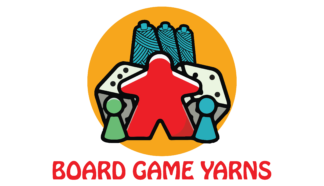
TLDR:
I added Judge Dredd: The Cursed Earth to my collection and I’m so glad I did!
It feels like playing through a comic/graphic novel.
In this article I consider how it compares to Arkham Horror: The Card Game and Escape the Dark Castle.
Spoiler alert: it’s similar but different.
Intro
So that didn’t take long! Having seen this in action at UKGE and pondering over whether to buy this or its progenitor, The Lost Expedition, I caved a few weeks ago and picked up a copy of Judge Dredd: The Cursed Earth from Amazon for an absolute steal of about seventeen GBP!
The first thing that stands out is that this is absolutely awash with 2000AD atmosphere. The artwork from Dredd artists Rufus Dayglo and Dan Cornwell was commissioned especially for this game, so it’s brand new and hasn’t just been lifted from existing sources. Also, the colour palette is extraordinarily vivid and most of the artwork leaps up at you from the surface of the cards. The larger card stock here also makes the art really sing.
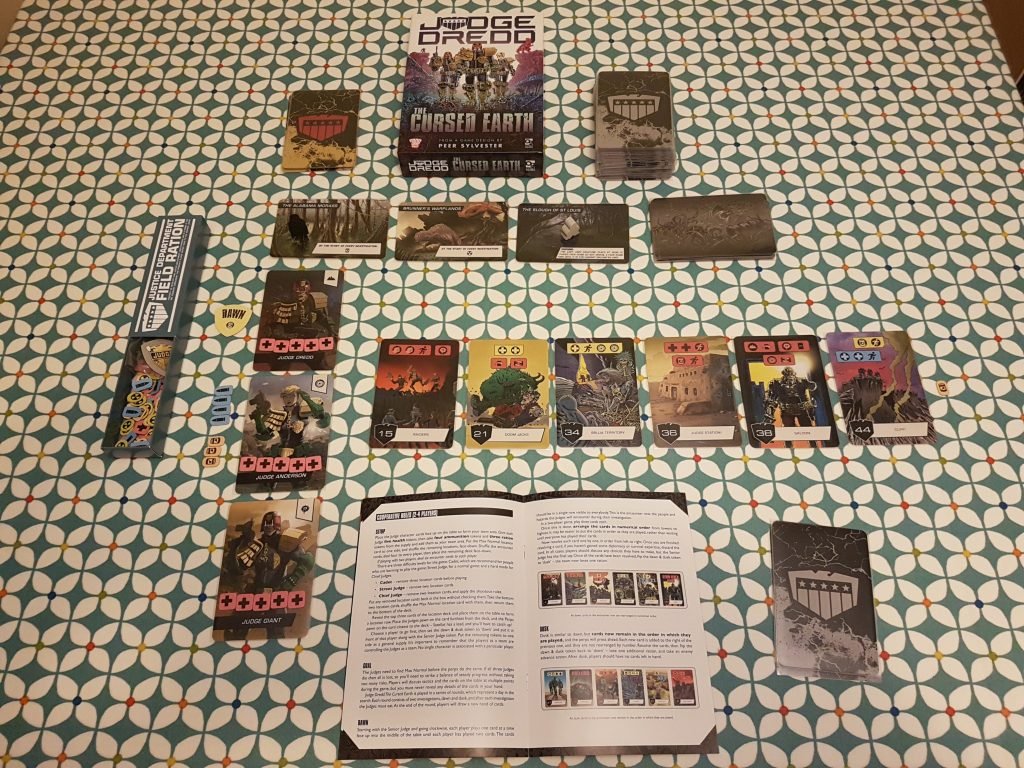
What’s in the box?
There’s not a lot in the box, but I do consider it to be good value – especially at the price I paid. The card stock is decent and the inclusion of the ‘Field Ration’ box to store your tokens in is a nice touch. Mmm… field rations. Taste the Justice!
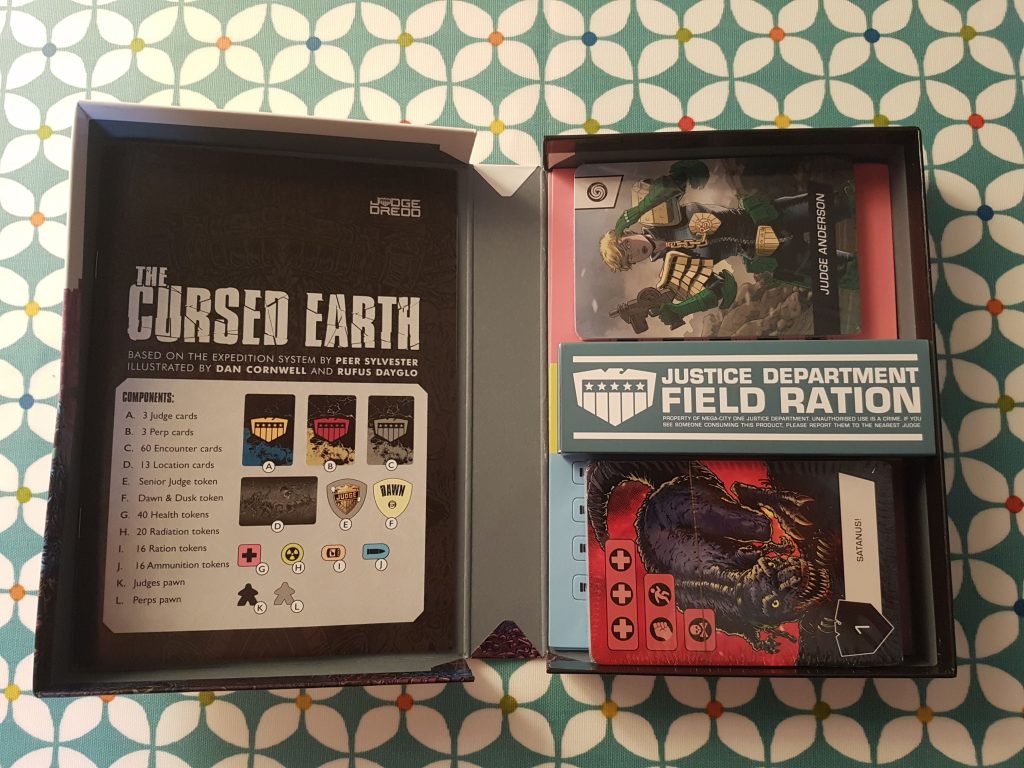
The rule book on the left.
Two sealed stacks of cards and the ration storage box on the right.
The token punch-board underneath, on the right.
The box is hinged and remains closed firmly, so everything stays put. Here’s a look at how I’m now storing everything in the box after sleeving the cards – it’s not much different. I’ve just used a couple of elastic bands to keep the cards together. The design of the storage has obviously been thought through with card sleeves in mind as it all fits perfectly.
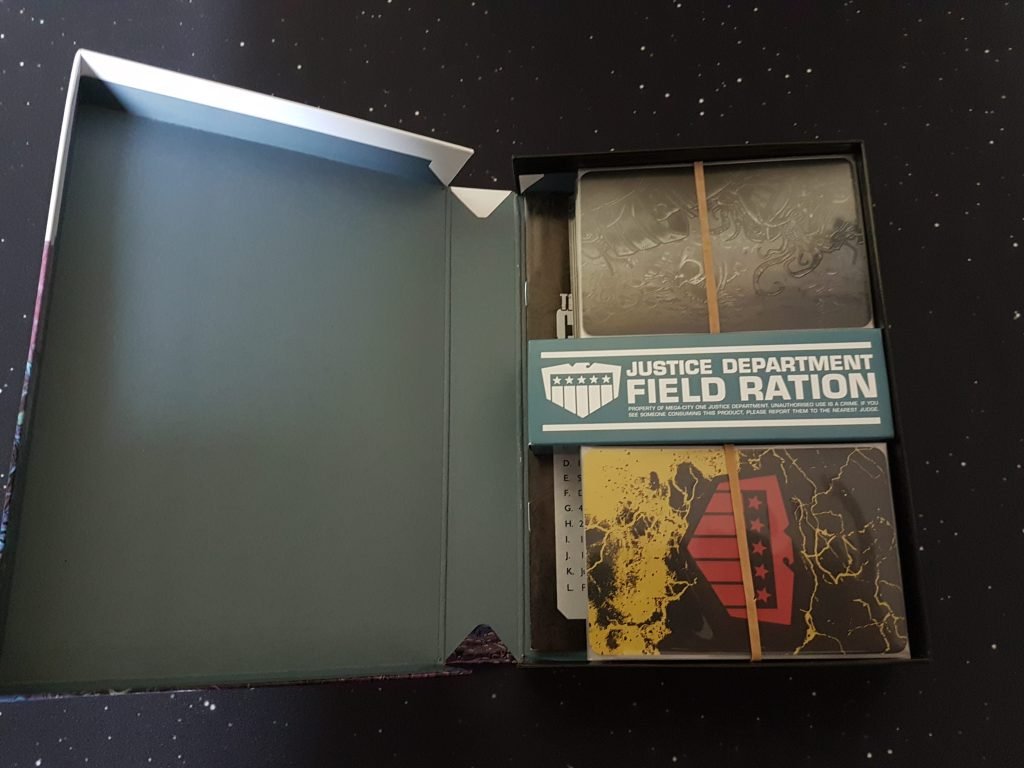
Sleeves
As you probably know by now if you’ve read any of my previous posts, I like to sleeve cards. I ordered two packs of DocsMagic 80×120 card sleeves. They come in packs of 50, so two are required to sleeve the 79 cards that come in Judge Dredd: The Cursed Earth.
They’re an almost perfect fit (shown below), with only 1-2mm extra at the long edges. There’s no extra top-to-bottom, where I find most card sleeves tend to leave way too much extra. Being a budget solution, consistency of DocsMagic sleeves can vary. Some of these were a bit cloudy, but that became much less noticeable once they were on the cards. After all, when you look through a sleeve before it’s on a card, you’re looking through two layers of it. When it’s on a card, you’re only looking through one layer and any clouding diminishes significantly. Price per sleeve, these are a bargain and I’d recommend them to anyone sleeving on a budget.
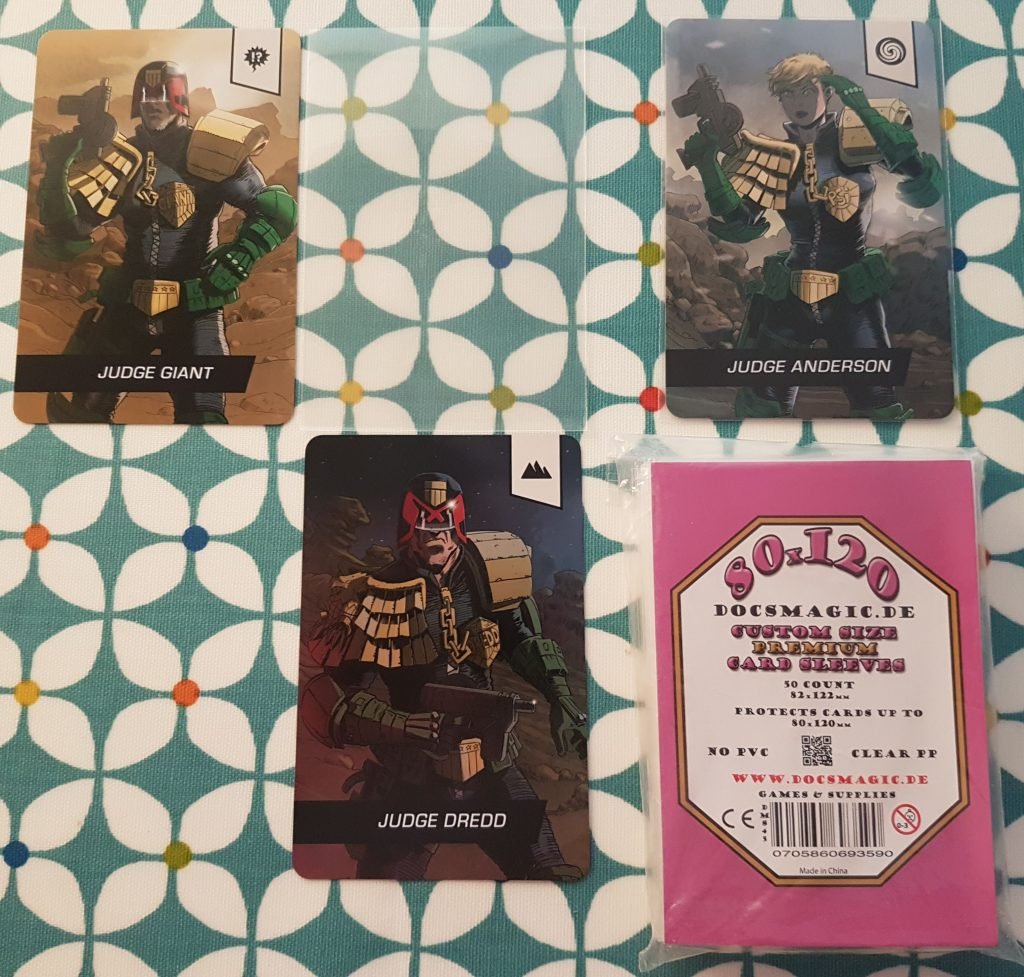
Aim of the Game
Playing as three of Mega-City One’s finest, your mission is to catch fugitive Max Normal. He’s suspected of carrying a deadly disease and Satellat’s evil forces are hoping to capture and exploit his condition for nefarious purposes. You must get to Max first!
Judge Dredd: The Cursed Earth is all about resource management and making the most of what you have – and you don’t have a lot! You only start the game with 5 health per character and a shared pool of four ammo and three rations, so these are whittled away quickly unless they are replenished.
The game is very flexible, enabling solo, cooperative (2-4 players) and a head-to-head competitive 2-player mode. In the solo/coop modes, you share control of the three Judges: Dredd, Anderson and Giant; each player is not assigned a single Judge. This encourages discussion and teamwork – the cornerstone to any decent cooperative gaming experience. 😉
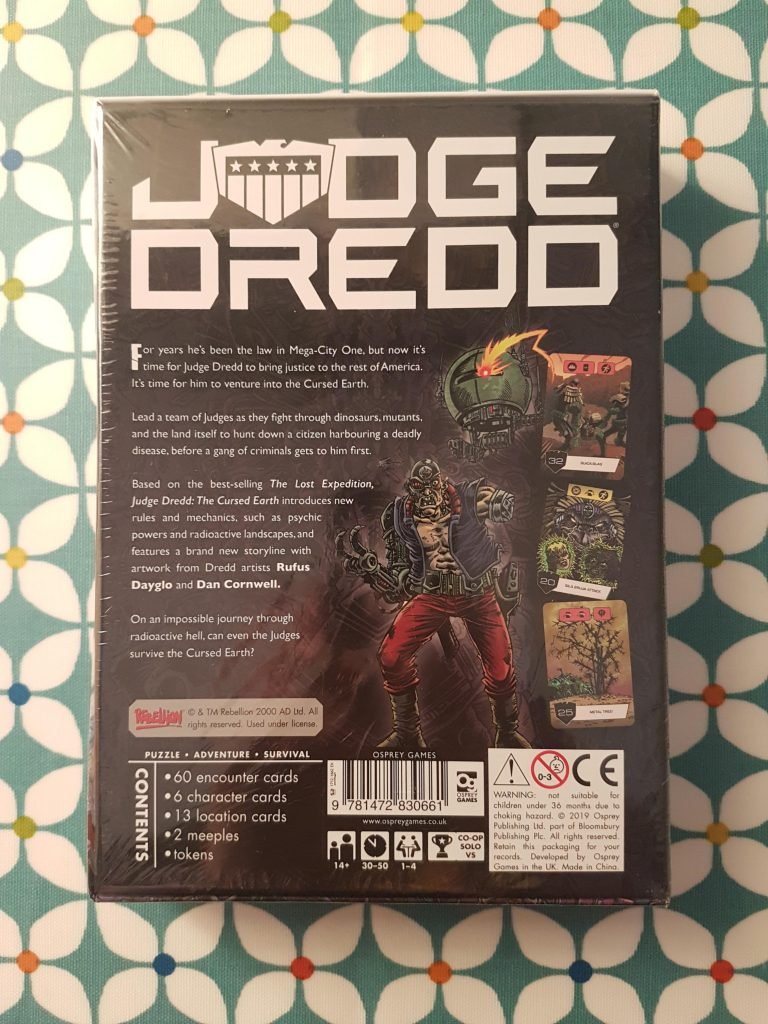
Learning to play
Having not played The Lost Expedition prior to picking this up, I had to learn from scratch, but that doesn’t take long. There are a few icons you have to remember, because apart from each card’s name and number there is no other text on the encounter cards. Most of the symbols make logical sense and there aren’t any complex rules behind them. The only one that needs a little extra attention is Judge Anderson’s Psi power, but even that is straightforward once you’ve used it a couple of times.
This player aid and rules summary by dmann on BGG are extremely useful. Big thanks to dmann for creating these and sharing them with the community! 🙂
You win some; you lose many
The game is played in a series of rounds until you:
a) succeed with the Judges reaching Max Normal before the perps
b) fail because all the Judges died
c) fail because you ran out of encounter cards
d) fail because the perps got to Max Normal first
As you can see above, there are multiple ways to fail and only one way to succeed – it’s a tough game!
In the head-to-head (2-player competitive) mode one of you plays as the Judges and the other as the perps. Either player can win if they reach Max normal first, but you also fail if all three of your Judges or perps die. Oh, and both players fail if the encounter deck runs dry!
Each round consists of a Dawn investigation and a Dusk investigation to represent the passage of one day during the Judges’ pursuit of Max. This is tracked using the dawn/dusk token. At the end of each Dawn investigation, the Judges eat breakfast, consuming one ration. At the end of each Dusk investigation, the Judges eat their evening meal, consuming another ration but they also take some time to sleep. Unfortunately, while the Judges are sleeping, the perps keep going and increase their lead by moving one additional step closer to finding Max! I think all of this adds nicely to the theme of a desert chase. It makes me think of western movies where the outlaws are being hunted by the law-bringers, with each party having to decide when to rest and when to press on.
The road ahead
Your journey is represented by the encounter row which is constructed from cards played from the encounter deck and/or players’ hands. Each player starts every round with four to six encounter cards, depending on the game mode. In coop mode, you take it in turns to play encounters from your hand until a total of six cards are in play. When playing solo, you draw two cards from the deck, then play two from your hand. After that you draw one more from the deck, followed by playing one more from your hand to make up the six encounters. (The rules for the competitive mode are slightly different again.)
At the bottom of the location deck, somewhere among the last 3 cards, lies Max Normal. You chase him by progressing from left to right along the location row. Judges are represented by a black meeple and the perps by a white meeple. In solo/coop the perps get a head start and begin the game on the third location card.
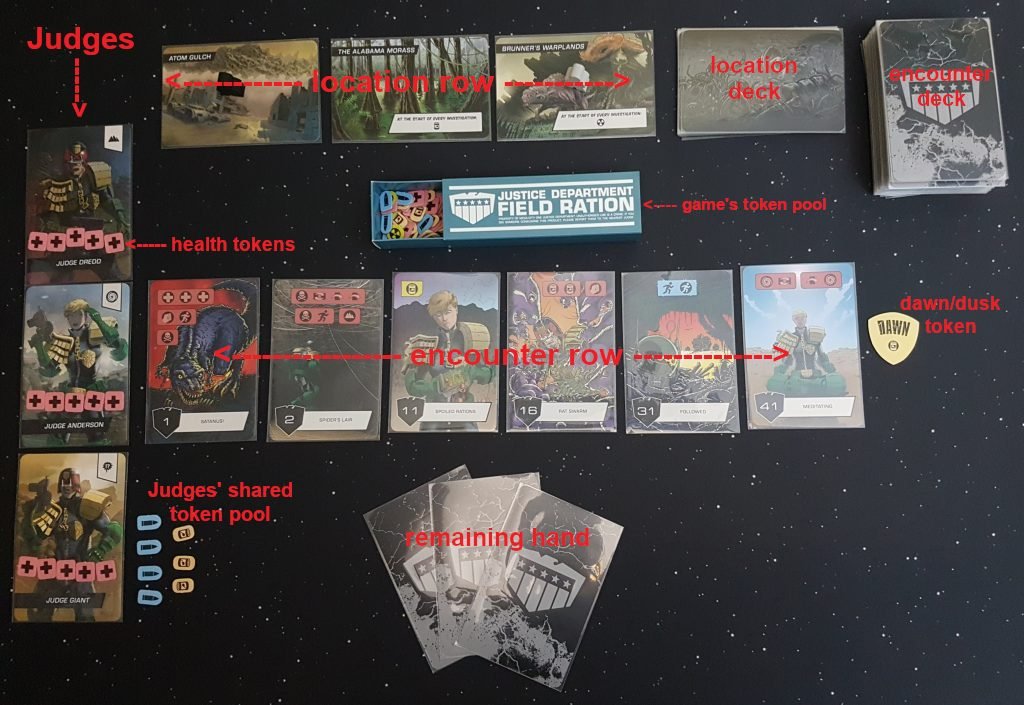
Close encounters
Each encounter card represents a challenge the Judges have to pass before moving on. Some encounter cards offer rewards for resolving them, but most will demand a sacrifice of either health, ammo or rations. Due to The Cursed Earth being highly irradiated, you also gain rads along the way. If a Judge ends up with more rads than you have health, guess what? They die!
Caption boxes appear on the encounter cards in several varieties: Yellow caption boxes are compulsory. Those in red usually appear in groups offering a choice and those in blue are completely optional and can be skipped and/or taken in addition to other caption boxes. There is a wide variety of encounters, some of which are clearly very bad for the Judges and some good. Some are a little more ambiguous and their impact will vary depending on the stage of the game you come across it.
The great thing about this being a card game rather than a board game is that the combinations of encounter cards will almost always be different for each game, due to how the cards are shuffled and drawn from the encounter deck. Same goes for the location deck to a certain extent, although there are less cards here and this is one area of the game that could do with an expansion to keep it fresh. Personally I hope we get more encounters and locations in any upcoming expansions. I’m not too fussed about new characters as this wouldn’t refresh the game as much, but I won’t complain if we get more of those too!
Experts in their field
In addition to the resources of health, ammo and rations, each Judge has their own area of expertise. Dredd’s is ‘diplomacy’. Hahahahaha! Yeah right! Who am I kidding?! Dredd’s is actually ‘survival’ and Judge Giant’s is ‘diplomacy’. Judge Anderson’s is ‘psi’ – where she uses her mind to reach out and interact with her environment.
If you come across a card with an expertise symbol your best bet is usually to let the Judge with the corresponding expertise resolve the encounter. If they do, they will only lose one health (or in Anderson’s case, take her psi test as described below). Alternatively you can choose for a different Judge (without the corresponding expertise) to lose two(!) health. This makes the late-game much trickier when you come across the Spider’s Lair and Dredd isn’t alive to use his survival expertise (and lose only one health), and you’re forced to make the difficult decision of leaving Anderson on one health or killing off Giant altogether!
The easy way
There is one much more agreeable way to resolve survival and diplomacy expertise encounters…
If you have previously completed an encounter that gives you a survival or diplomacy symbol, you may keep it in the Judges’ shared pool until you come across an encounter that requires a survival or diplomacy icon to complete it. You can then spend this card’s expertise to complete that encounter without further penalty, discarding the card afterwards. This is instead of the Judge with the corresponding expertise having to lose one health. Psi is an innate ability that Anderson has and so cannot be acquired and stored this way.
Psi
In Anderson’s case her volatile psi ability works differently and it can often go haywire, costing you dearly. However, it could work to your advantage if the right cards come out. Triggering this ability in any game mode is a gamble but you do get a choice how you resolve it: in solo mode you can opt to add one more encounter card (drawn blindly from the deck) to the encounter row. Alternatively, you can choose to lose one health and draw four(!) cards from the encounter deck, playing only two of your choosing to the encounter row! Now depending on what stage of the game you’re at and how many resources you have left, the latter could pay off if you draw at least two positive cards that you are able to play and resolve without too great a penalty. However, this can easily go horribly wrong, with you left having to pick the best of a bad bunch if all four of those cards are tough.
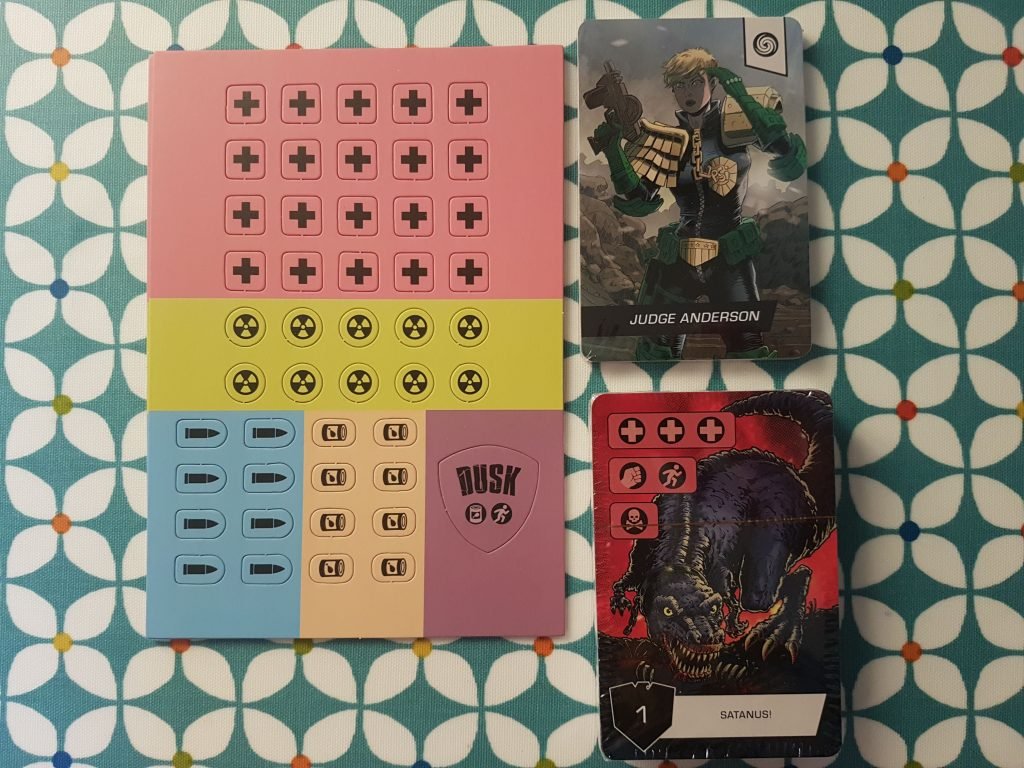
Also shown is the punchboard of tokens and encounter card no.1, ‘Satanus!’ You can deal with Satanus by taking 3 health damage, or by spending ammo to fight and let the perps move ahead, or by outright killing one Judge! Harsh, but fair.
Theme
I mentioned earlier how I like the similarities this game has to a western movie. The pursuit, the bandits vs law-bringers, the tumbleweed – yes there’s even tumbleweed, although in this game it’s more like balls of razor wire and it hurts! The theme on the cards is very accessible, with every card clearly explaining itself through the gorgeous artwork and the positive or negative symbols present. For most symbols, like health for instance, a plus symbol on its own represents a gain i.e. you gain one health. However, a plus symbol in a circle means you lose one health. So symbols are good and symbols in circles are bad.
Let’s look at some example cards in a bit more detail…
Take ‘Irradiated Vehicle’ (shown below, left), where you can choose to take shelter from the cruel desert wind and sun to recuperate, but you also take some rads. You can then choose to move on or stay a bit longer, rummage around to find some ammo – but you take some more rads in the process!
Or in the case of ‘Judge Station!’ (shown below, right). This is a place where the Judges can take a break away from the scorching badlands, but it comes with a choice: Recover two health and let the perps advance ahead of you or take time to eat (consume one ration) and then push on, gaining on the perps and getting one step closer to catching Max Normal.
It’s all about risk vs reward.
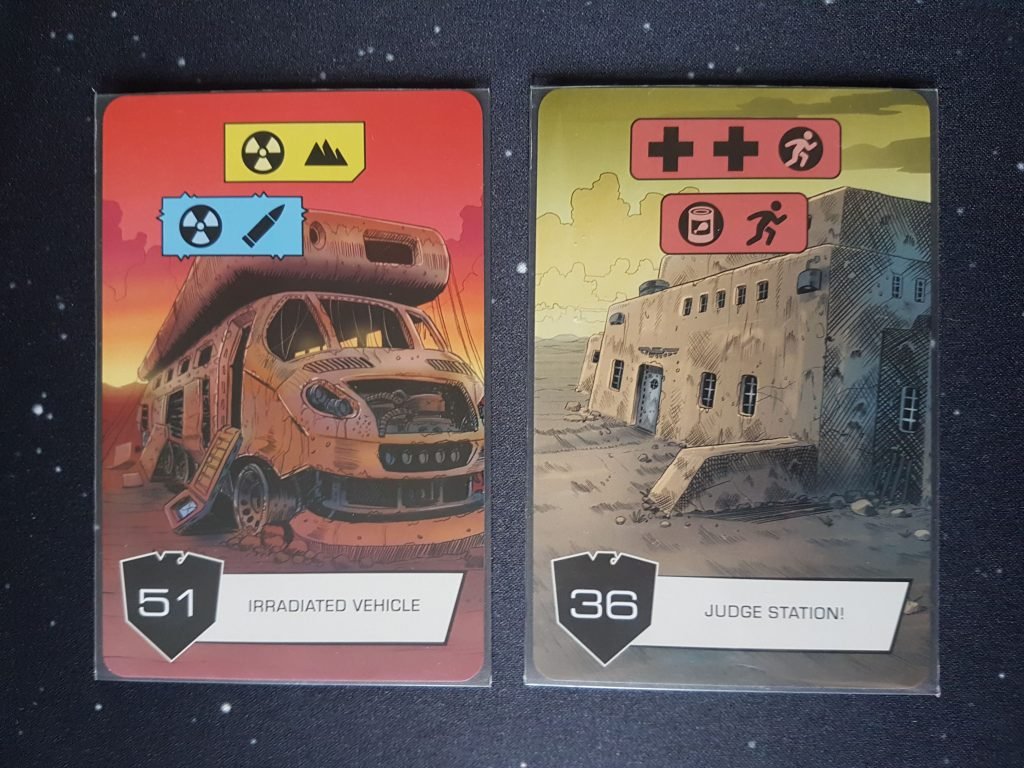
Cards like these really bring this game to life by riffing off its comic/graphic novel roots. If found this one of the more pleasantly surprising elements to this game because I’m used to playing Arkham Horror: TCG which has loads of text on its cards and really immerses you in its mythology through the written word (as well as some stellar artwork btw). When I first laid eyes on the Judge Dredd cards, they seemed oddly oblique. They have nothing but card names and numbers written on them, but once you know how to interpret the symbols, it quickly becomes like reading a page in a comic book that is devoid of dialogue and has but a sprinkling of narration – you get everything you need to know from the art alone. Brilliant!
Difficulty

Have I mentioned that this game is tough?! I’ve still not beaten it on even the easiest setting after multiple solo playthroughs. I haven’t played at other player counts yet, so maybe it’ll get easier with more players. I kinda doubt it. Just like Arkham Horror: The Card Game it appears to have been designed to stomp you into the ground with impunity unless the stars align perfectly in your favour. And I’m fine with that. It adds to replayability and I’m always more interested in the journey than the destination. Almost every game has ended differently for me so far. The most common outcome is that the perps get to Max first and start harvesting his bone marrow to make virulent biological weapons before the Judges even caught sight of the poor fella. Today’s session ended with all three Judges dying miserably in the desert: Anderson was utterly irradiated, Giant was defeated by the Gila Bruja clan and Dredd had all his rations eaten by a rat swarm, leaving him to starve! The Judges may be unstoppable justice-dispensing war machines in Mega-City One, but they are out of their element roaming the cruel landscape of the Cursed Earth.
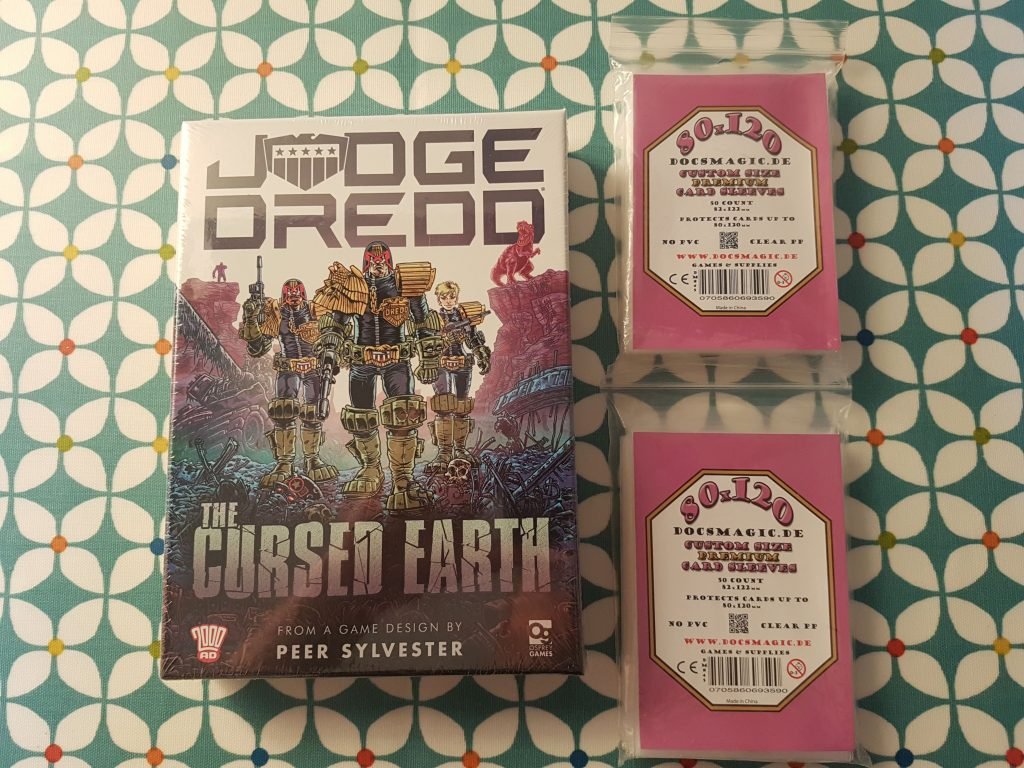
Final thoughts
This game sits among my collection with Escape the Dark Castle and Arkham Horror: The Card Game as another encounter-based card game. They can all be tough as nails to beat but each one does things differently:
Look and Feel
- Judge Dredd: The Cursed Earth feels like playing through a graphic novel – the rulebook even has two pages of comic strip setting up the scenario! With lots of iconography and very little text, its flavour comes entirely from the artwork.
- Arkham Horror: The Card Game is heavily lore-focused and feels like you are the unlikely hero (more often victim!) of a classic horror novel. It also has lots of text driving the narrative experience, with both art and text adding flavour.
- Escape the Dark Castle is a choose your own adventure story driven by text with artwork for flavour.
Control and Agency
- Judge Dredd: The Cursed Earth allows players to influence the order in which encounters are played to the table but once they’re on the table they’re locked in, with only some cards offering choices as to how you resolve them.
- Escape the Dark Castle is a much more linear experience (you progress through a stack of encounters in order), yet players can still choose how to how resolve most encounters, usually from two available options.
- Arkham Horror: The Card game is the heaviest of the bunch and takes a lot more time to learn even the basics. However, it offers a great deal of agency to the players. You can navigate adjacent encounters in whatever order you like and each scenario has multiple possible outcomes.
Background and Influences
For each of these games, I think players can have a richer experience if they immerse themselves in the properties that inspired them:
- Arkham Horror: The Card Game draws on (mostly Lovecraftian) horror novels and movies
- Judge Dredd: The Cursed Earth spawned from the 2000AD comics/graphic novels
- Escape the Dark Castle is heavily influenced by Steve Jackson & Ian Livingstone’s Fighting Fantasy books
Each game pays such careful homage to their respective source that if you’ve read or watched the source, one can notice little flourishes and nods along the way. However, what impresses me most about these games is that even if you don’t know the source material, they are still great fun to play! For a lot of people their first experience of Judge Dredd might be this very game, and hopefully it drives people to seek out the original comics and graphic novels. Judge Dredd has been part of our world for two years more than I have, so the fact that Osprey Games is publishing new and exciting ways to keep his story alive and bring it to different audiences can only be a good thing.
My preference
As to which of these three I will reach for on the shelf, I can see Judge Dredd: The Cursed Earth being my most frequent go-to for sheer convenience. It’s compact and quick to setup and tear down, with playtime at 15 mins or less in solo mode. However, it’s good to know I have all bases covered for a light, medium and heavy encounter-based card game, all of which have themes which resonate well with my interests and preferences. Depending on what mood I’m in, how much time I have and how much brain power I wish to use, I’m confident one of these three will scratch that itch every time. Not to say that I won’t at some point add more encounter-based card games to my collection… let’s not get too hasty! 😉
p.s. Looking at things another way…
I tried something new this time to represent some of my thoughts about these three games. This might help readers decide which is the best fit for them:
| Category | Least | The middle ground | Most |
| Dependent on established IP | Escape the Dark Castle | Arkham Horror: The Card Game | Judge Dredd: The Cursed Earth |
| Complexity | Escape the Dark Castle | Judge Dredd: The Cursed Earth | Arkham Horror: The Card Game |
| Playtime | Judge Dredd: The Cursed Earth | Escape the Dark Castle | Arkham Horror: The Card Game |
| Linearity | Arkham Horror: The Card Game | Judge Dredd: The Cursed Earth | Escape the Dark Castle |
| Luck-based (RNG) | Judge Dredd: The Cursed Earth | Escape the Dark Castle | Arkham Horror: The Card Game |
Honorable mention

Error: No feed found.
Please go to the Instagram Feed settings page to create a feed.
